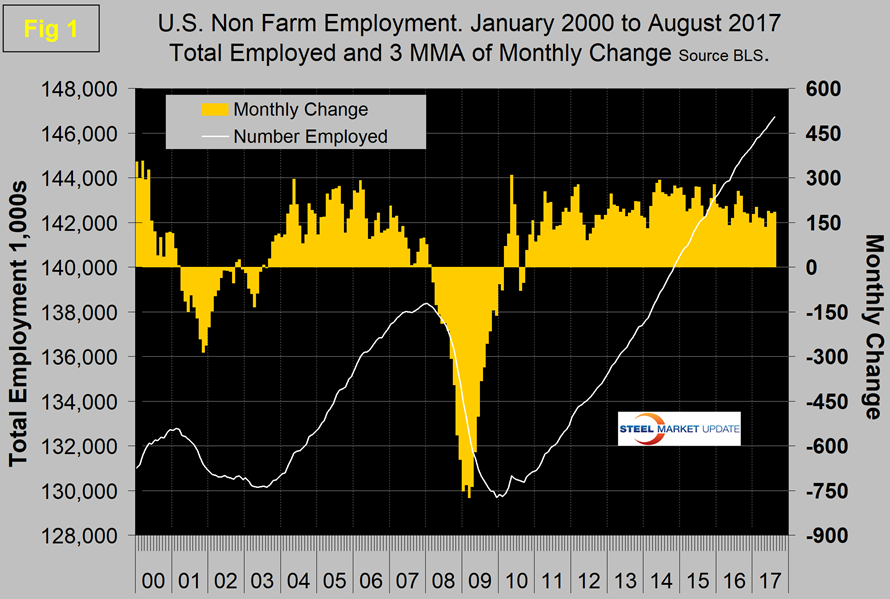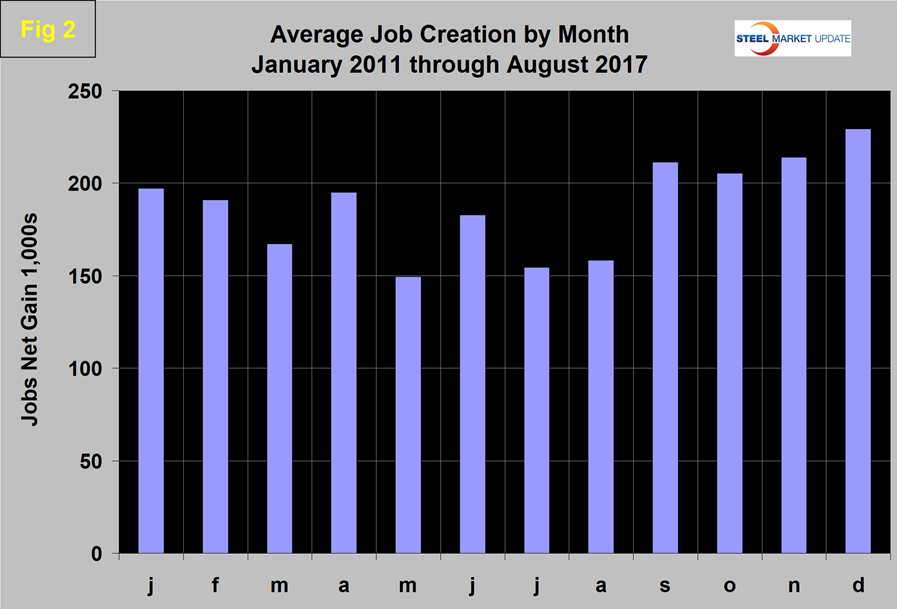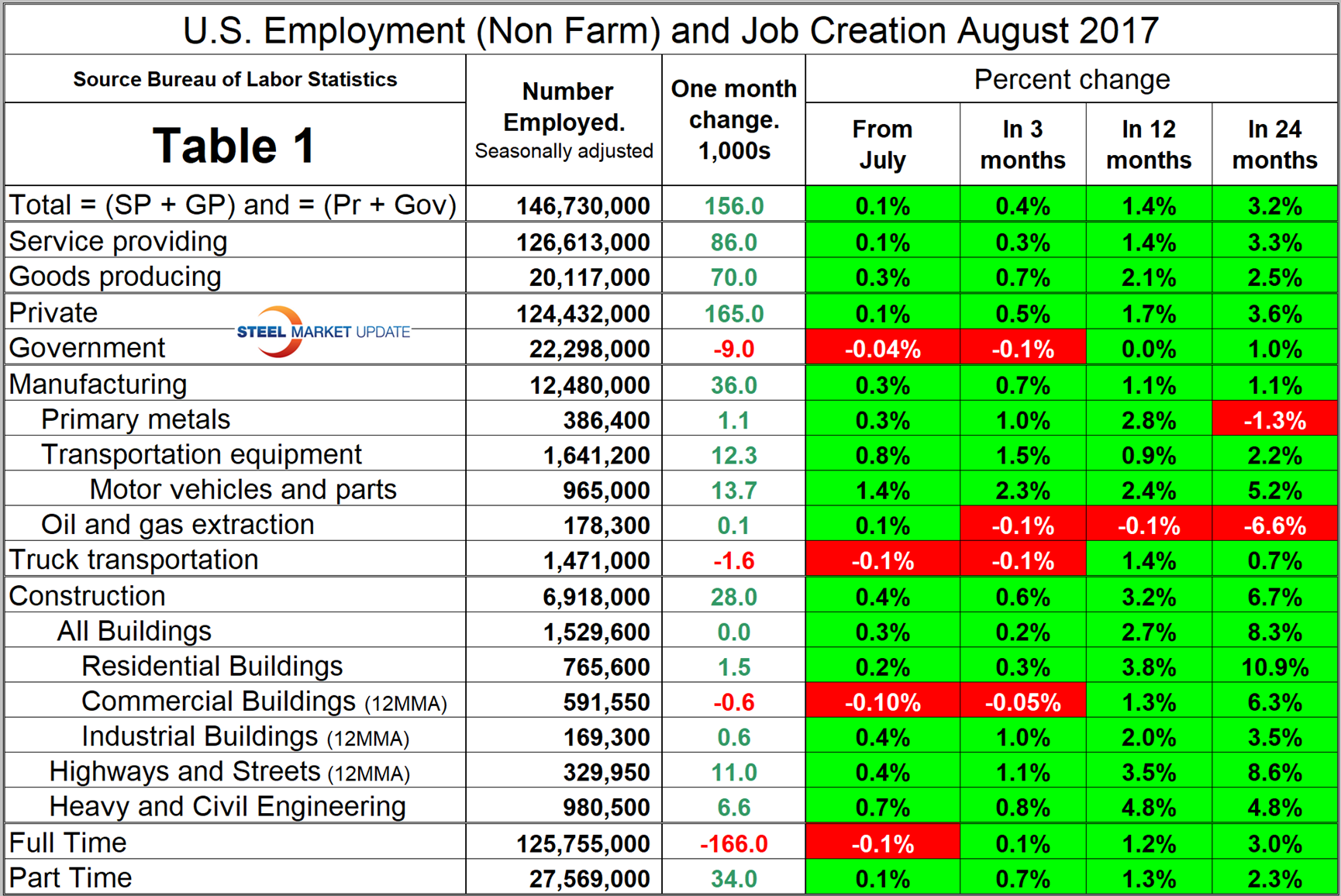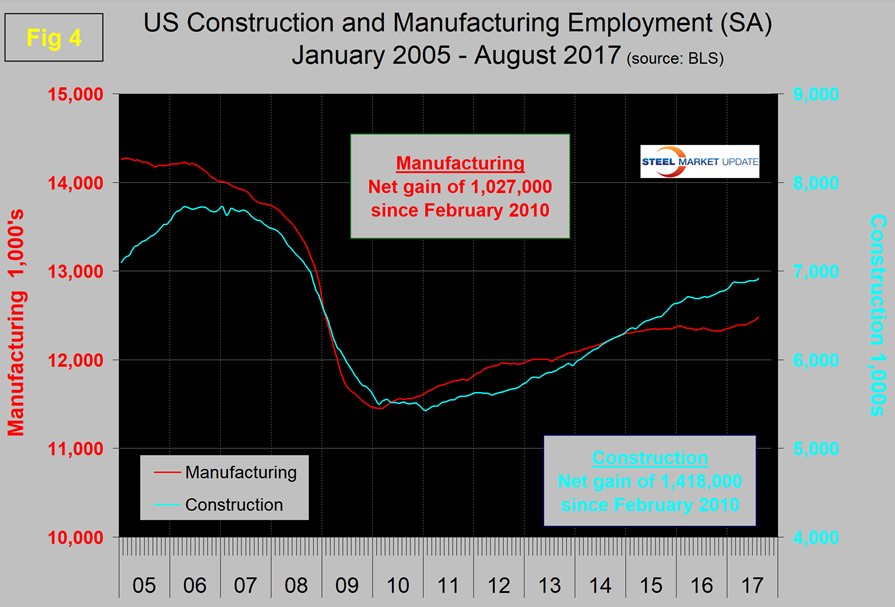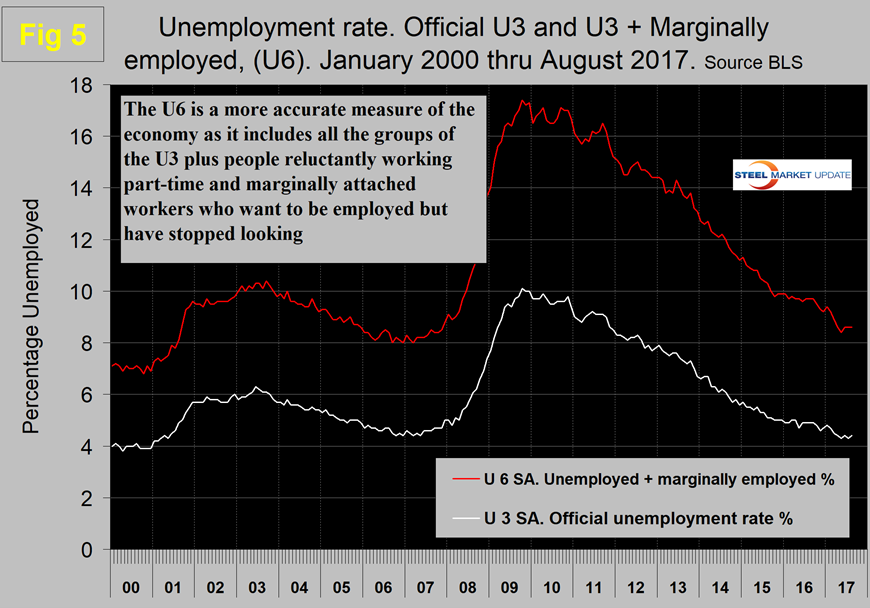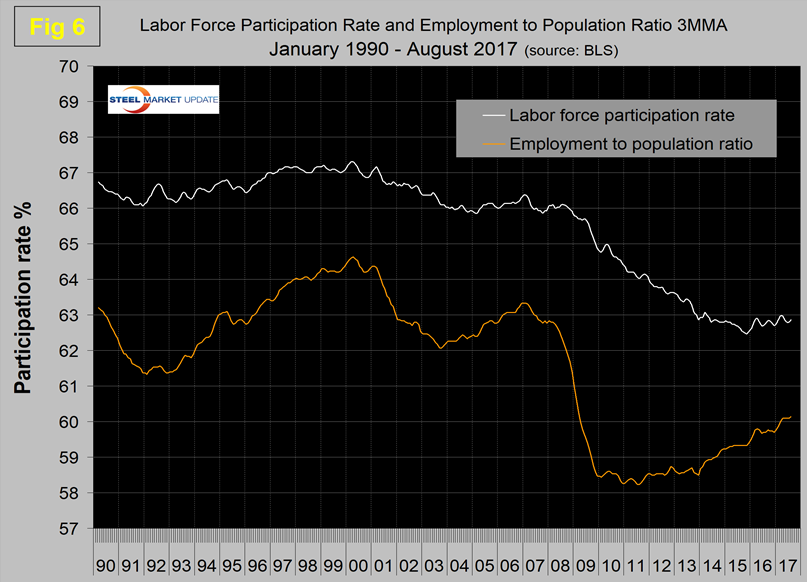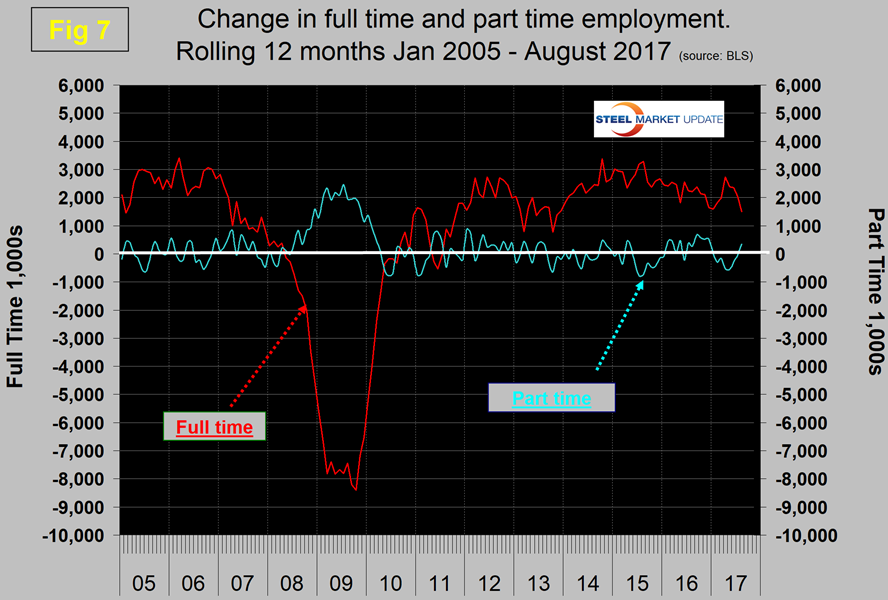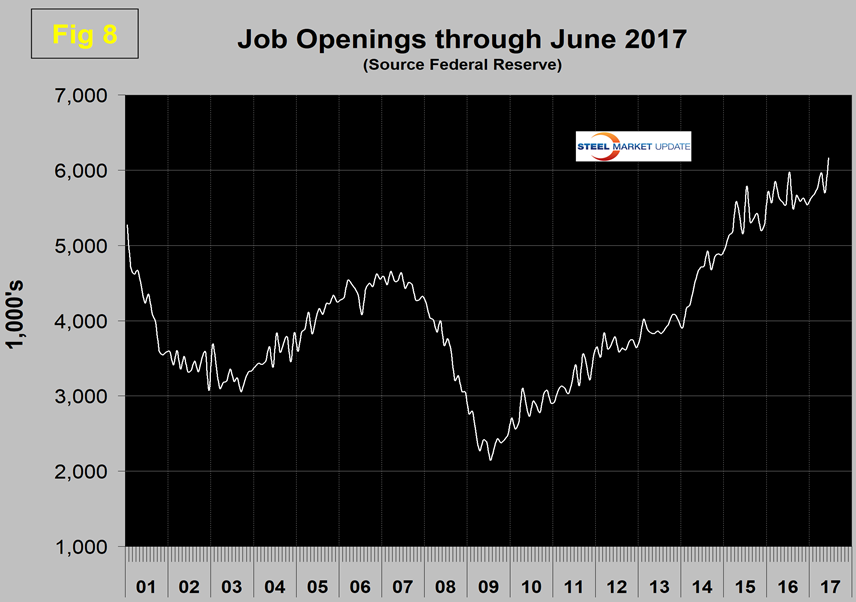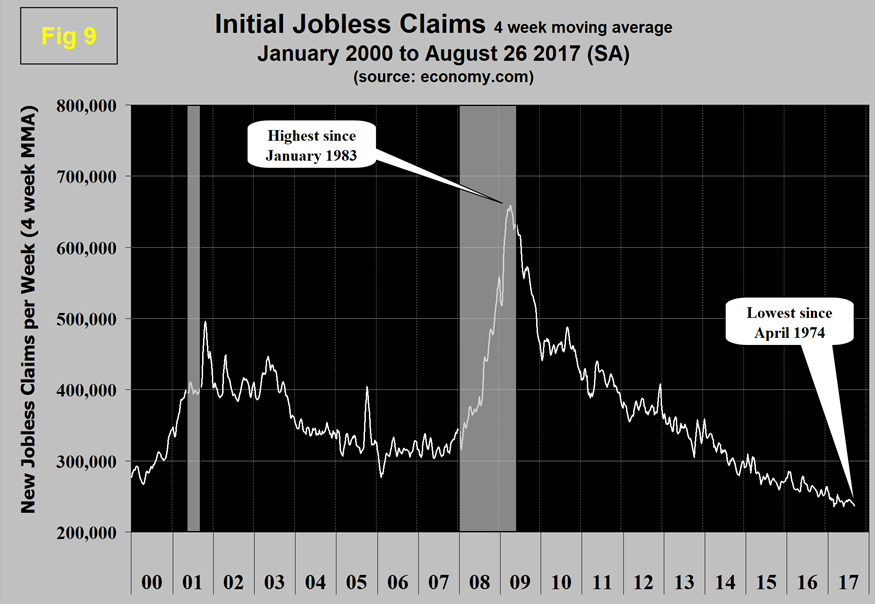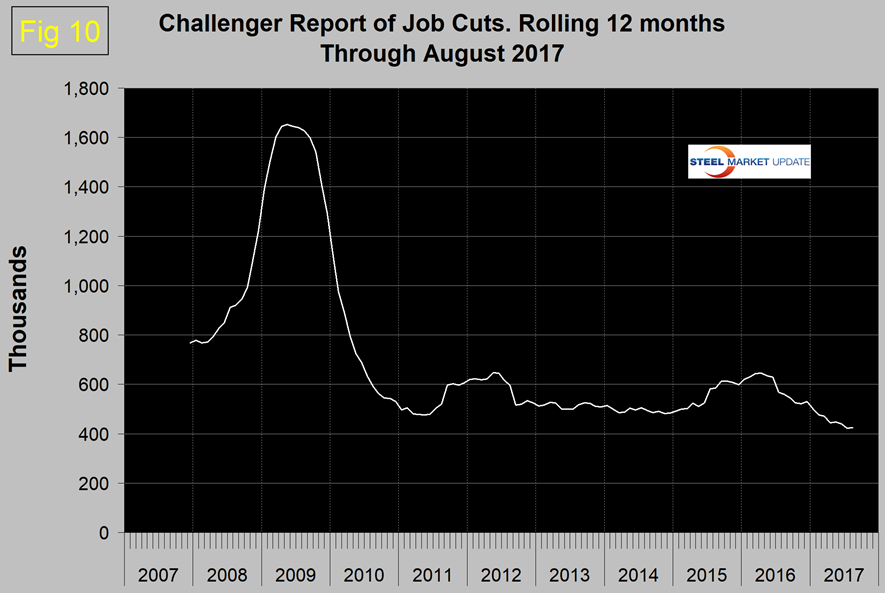Economy

Construction, Manufacturing Lead August Jobs Growth
Written by Peter Wright
September 5, 2017
Employment growth in both construction and manufacturing was strong in August.
The Bureau of Labor Statistics (BLS) net job creation report released on Friday was disappointing in total, but unusual in the detail. Disappointing because employment growth was worse than normal for August. Unusual in that the ratio of goods-producing to service-industry job growth was the best since July 2011.
About 156,000 jobs were created in August, according to preliminary BLS data. That compares to final figures of 210,000 in June and 189,000 in July. The preliminary numbers in June and July were revised down by a combined 41,000, but remained positive.
Moody’s Analytics expects the labor market’s winning streak to continue over the next year. The calamity caused by the flooding in Texas and Louisiana will result in some temporary weakness in coming months, particularly September, but recovery efforts will result in new demand for workers no later than November. The energy industry will certainly perform worse as less drilling takes place.
The brown bars in Figure 1 show the three-month moving average (3MMA) of the number of jobs created monthly since 1990. The white line tracks the number employed. There has barely been a blip in the trajectory of this curve in the last six years.
The results are seasonally adjusted by the BLS. To see if any seasonality is left in the data after adjustment, we have developed Figure 2. In the seven years since and including 2011, job creation in August has grown by 2.0 percent. This year, August jobs declined by 17.0 percent, which is why we find the overall result disappointing. History says that September will surge, but based on Moody’s observation this may not happen.
Total nonfarm payrolls are now 8,365,000 more than they were at the pre-recession high of January 2008. November 2014 was the first month for total nonfarm employment to exceed 140 million. At the end of August, 146,730,000 people were employed.
Table 1 breaks out the total number employed in private, government, service and goods-producing industries and the change in those sectors in the latest month of data. It includes the percentage growth in three, 12 and 24 months. Most of the goods-producing employees work in manufacturing and construction. We have identified the components of these two sectors that are most relevant to steel consumption. In August, 165,000 jobs were created in the private sector, while government lost 9,000. Not relevant to steel but of interest from a tax dollars point of view, the federal government lost 1,000 positions as state governments lost 5,000 and municipal governments lost 3,000 jobs.
Since February 2010, the employment low point, private employers have added 17,175,000 jobs as government has shed 178,000 as shown in Figure 3. (The spike in government employees in May 2010 was the temporary employment of census workers).
In August, service industries expanded by 86,000 as goods-producing industries, driven by both construction and manufacturing, expanded by 70,000. Each month, we shake our heads at the widening gap between the number of people employed in services and those in the steel-consuming sectors of manufacturing and construction. Since February 2010, service industries have added 14,507,000 jobs and goods-producing 2,490,000 positions. In other words, goods-producing industries (mainly manufacturing and production) have created only 17 percent as many jobs as service industries. In August, goods producing was 80 percent of the service industry gain. This was the best since July 2011. The widening of the gap between services and goods producing is part of the reason why wage growth has been slow since the recession, as service industries on average pay less than goods-producing industries such as manufacturing.
In August, manufacturing gained 36,000 positions for a total of 137,000 in the first eight months of 2017. Only one month had a better manufacturing gain than August since the recession. Manufacturing employment has increased by 0.7 percent in three months and by 1.1 percent in 12 months. Table 1 shows that primary metals have done much better than manufacturing as a whole in the last 12 months.
Within the big picture of manufacturing, transportation equipment and automotive parts had double-digit gains in the month as the auto companies started back up after their summer shutdowns. Oil and gas extraction broke positive in August after over two years of decline. Truck transportation has lost ground in the last three months, but not by much. Note the subcomponents of both manufacturing and construction shown in Table 1 don’t add up to the total because we have only included those that we think have most relevance to the steel industry.
Construction was reported to have gained 28,000 jobs in August and is up by 135,000 in the first eight months of 2017. Some of the major construction subcategories are routinely reported one month in arrears, which distorts the data in Table 1. These include industrial buildings, commercial buildings, and highways and streets. Construction has added 1,418,000 jobs and manufacturing 1,027,000 since the recessionary employment low point in February 2010 (Figure 4).
Construction has leapt ahead of manufacturing as a job creator, but the growth of construction productivity is very low (or non-existent) in contrast to manufacturing, which historically has been much higher. The difference is the difficulty of automating construction jobs.
The official unemployment rate, U3, reported in the BLS household survey (see explanation below) came in at 4.4 percent in August, which was up from 4.3 percent in July but down from 4.9 percent in August last year. This number doesn’t account for those who have stopped looking for work. The more comprehensive U6 unemployment rate declined from 9.7 percent in August 2016 to 8.6 percent in August 2017 (Figure 5). U6 includes workers working part time who desire full-time work and people who want to work but are so discouraged they have stopped looking. The differential between these rates was usually less than 4 percent before the recession, but is still at 4.2 percent.
The employment participation rate at 62.9 percent in August hasn’t changed much in the last 12 months. We’re not sure what this is a percentage “of” because of the multiple descriptions of the labor pool. Another measure is the number employed as a percentage of the population, which seems to be much more definitive. In August, this measure was 60.1 percent, up from 59.7 percent in August last year and from 59.4 percent in August 2015. Figure 6 shows both the participation rate and the employment-to-population ratio on the same graph. It has been estimated that the economy needs to create about 150,000 jobs per month to keep up with population growth. In the last 12 months, the average monthly job creation has been 156,000 per month. Therefore, since the employment-to-population ratio has improved, it looks as though the 150,000 number is too high.
In the 32 months since and including January 2015, there has been an increase of 5,821,000 full-time and 63,000 part-time jobs. Figure 7 shows the rolling 12-month total change in both part-time and full-time employment. This data comes from the household survey and part-time is defined as less than 35 hours per week. Because the full-time/part-time data comes from the Household survey and the headline job creation number comes from the Establishment survey, the two cannot be compared in any particular month. To overcome the volatility in the part-time numbers, we must look at longer time periods than one month or even one quarter, which is why we look at a rolling 12 months for this component of the employment picture shown in Figure 7.
The job openings report known as JOLTS is reported on about the 10th of each month by the Federal Reserve and is more than a month in arrears. Figure 8 shows the history of unfilled job openings through June when openings stood at 6,144,000, an all-time high. There has been an improving trend since mid-2009.
Initial claims for unemployment insurance, reported weekly by the Department of Labor, have continued their downward drift this year. In the week ending Aug. 26, claims totaled 236,000 with a four-week moving average of 235,750. This marks the longest streak since 1973 of initial claims below 300,000 (Figure 9). The result for the week ending Feb. 4, 2017, at 231,000, was the lowest in 43 years, since April 1974.
Economy.com had this to say last Thursday: “The effects of Hurricane Harvey will begin to be visible in high-frequency U.S. economic data. The first will be initial claims for unemployment insurance benefits. Hurricanes initially depress claims by preventing them from being filed and processed. This backlog is worked off in subsequent weeks, temporarily boosting initial claims.”
The last piece of the employment puzzle that we examine is the Challenger report, which measures job cuts monthly (Figure 10). This data also tends to be quite erratic. Looking at a rolling 12 months to smooth out the data, we can see that job cuts decreased for most of 2016 and continued their downward trend in 2017. The result for August was the lowest since our data stream began at the end of 2007. The construction sector had the highest number of job cuts with 4,332 in the month of August. The retail sector has had the highest number of job cuts year to date at 67,596. This was over 50 percent higher than in the first eight months of 2016.
SMU Comment: Despite August having a lower than normal job creation result, we are very encouraged by the overall situation. Job growth in both construction and manufacturing was strong in August. Applications for new unemployment insurance are at a 40-year low. Job openings are at an all-time high and job cuts have been declining for over a year. This bodes well for the steel business, at least in the short term. August 2017 was the 89th consecutive month of job growth on a 3MMA basis. The mid 1990s was the longest sustained period of job growth since the 1940s when the streak was 96 months.
Explanation: On the first Friday of each month, the Bureau of Labor Statistics releases the employment data for the previous month. Data is available at www.bls.gov. The BLS reports on the results of two surveys. The Establishment survey reports the actual number employed by industry. The Household survey reports on the unemployment rate, participation rate, earnings, average workweek, the breakout into full-time and part-time workers, the age breakdown of the unemployed, and reasons for and duration of unemployment. At SMU, we track the job creation numbers by many different categories. The BLS data base is a reality check for other economic data streams such as manufacturing and construction, and we include the net job creation figures for those two sectors in our “Key Indicators” report. It is easy to drill down into the BLS database to obtain employment data for many subsectors of the economy. For example, among hundreds of sub-indexes are truck transportation, auto production and primary metals production. The important point about each of these many data streams is in which direction they are headed. Whenever possible, we try to track three separate data sources for a given steel-related sector of the economy. We believe this gives a reasonable picture of market direction. The BLS data is one of the most important sources of fine-grained economic data that we use in our analyses. The states also collect their own employment numbers independently of the BLS. The compiled state data compares well with the federal data. Every three months, SMU examines the state data and provides a regional report that indicates strength or weakness on a geographic basis. Reports by individual state can be produced on request.

Peter Wright
Read more from Peter WrightLatest in Economy

Chicago Business Barometer falls back in April, remains in contraction
The Chicago Business Barometer declined in April, reversing March’s gains, according to Market News International (MNI) and the Institute for Supply Management (ISM).

Fewer manufacturers optimistic about the economy
PMA’s April report shows that only 16% of surveyed manufacturers anticipate an increase in economic activity in the next three months (down from 23% in March)

Architecture billings continue to slide in March
Architecture firms said billings continued to decline in March, according to the latest Architecture Billings Index (ABI) released by the American Institute of Architects (AIA) and Deltek.

Beige Book shows concerns about trade policy
Manufacturing was mixed, but two-thirds of districts said activity was little changed or had declined.

New York state manufacturing index drops again in April
Firms were pessimistic, with the future general business conditions index falling to its second lowest reading in the more than 20-year history of the survey

